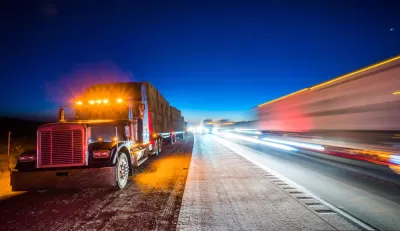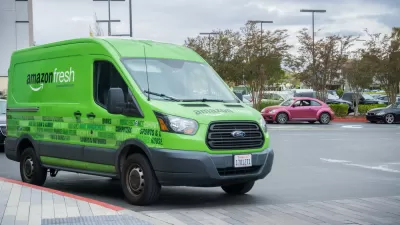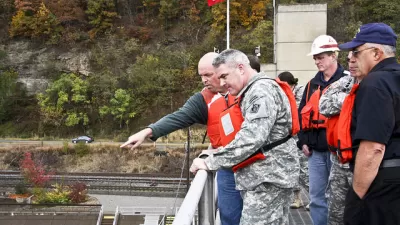A powerful lobby is more in interested in protecting its monopoly than lessening congestion and pollution.

"For many Americans, the experience of driving on a coastal highway like Interstate 5 in California can be a nightmare of dodging massive trucks hauling cargo between US cities," reports Erik Olsen.
According to Olsen, only 2 percent of domestic freight moving among the Lower 48 states moves by sea, despite the fact that about half the population lives near the coast.
The reason so much freight moves on the nation's roadways is the subject of Olsen's article, and credit goes to the Jones Act. The Jones Act, passed shortly after World War I, "preserves a monopoly for US-built, owned and operated ships to transport goods between US ports."
According to Olsen, the law was designed to protect American shipbuilding and "ensure that the US had ample ships to conduct international trade." The law didn't manage to protect the industry, however, and now "there are some 171 privately-owned US flagged ships today. Just 93 of them are Jones Act-eligible."
Thus, the consequences of the Jones Act in 2017 include higher costs for consumer goods as well as more freight on trucks. The latter, according to Olsen, "significantly increasing highways congestion, intensifying air pollution and further degrading the country’s infrastructure."
Olsen provides additional details about the consequences of the Jones Act, and discusses the business interests that have made the law virtually impossible to overturn.
FULL STORY: An arcane American law protected by powerful interests is causing insane traffic jams

Montreal Mall to Become 6,000 Housing Units
Place Versailles will be transformed into a mixed-use complex over the next 25 years.

Planetizen Federal Action Tracker
A weekly monitor of how Trump’s orders and actions are impacting planners and planning in America.

DARTSpace Platform Streamlines Dallas TOD Application Process
The Dallas transit agency hopes a shorter permitting timeline will boost transit-oriented development around rail stations.

Study: 4% of Truckers Lack a Valid Commercial License
Over 56% of inspected trucks had other violations.

Chicago Judge Orders Thousands of Accessible Ped Signals
Only 3% of the city's crossing signals are currently accessible to blind pedestrians.

Philadelphia Swaps Car Lanes for Bikeways in Unanimous Vote
The project will transform one of the handful of streets responsible for 80% of the city’s major crashes.
Urban Design for Planners 1: Software Tools
This six-course series explores essential urban design concepts using open source software and equips planners with the tools they need to participate fully in the urban design process.
Planning for Universal Design
Learn the tools for implementing Universal Design in planning regulations.
City of Mt Shasta
City of Camden Redevelopment Agency
City of Astoria
Transportation Research & Education Center (TREC) at Portland State University
US High Speed Rail Association
City of Camden Redevelopment Agency
Municipality of Princeton (NJ)




























